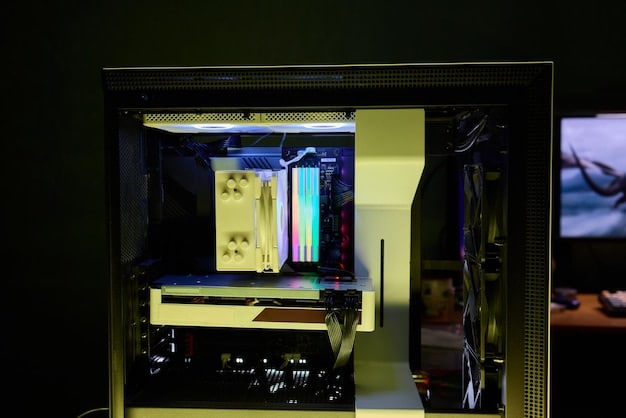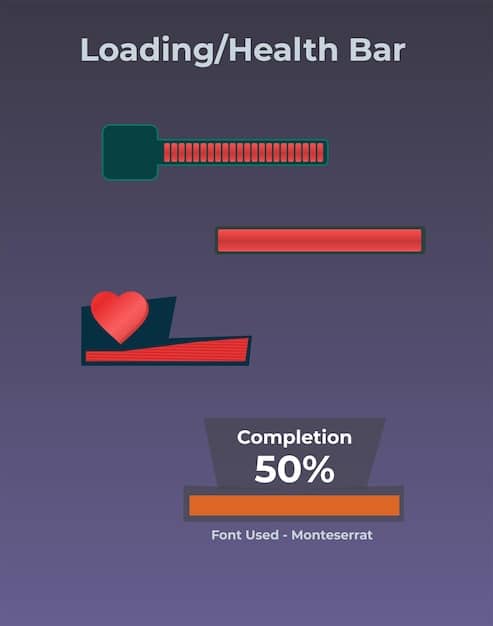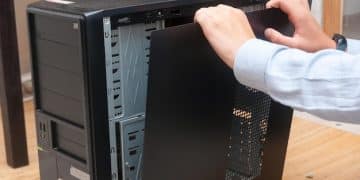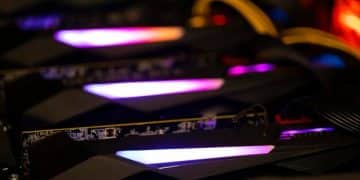SSD Upgrade: Boost Gaming Load Times 5X Faster Now

Upgrading to an SSD can dramatically cut game loading times by up to five times, transforming your gaming experience with quicker access and smoother transitions between levels, a crucial improvement for any avid gamer.
In the competitive and fast-paced world of gaming, every second counts. Are you tired of staring at loading screens, waiting for your favorite games to finally begin? It’s a common frustration that can disrupt the immersive experience and pull you out of the action. The solution might be simpler, and more impactful, than you think: Don’t Wait: Upgrade Your SSD Now for 5x Faster Game Loading Times, a move that can fundamentally change how you interact with your digital worlds.
The Bottleneck: Why Traditional Hard Drives Lag Behind
For decades, the traditional Hard Disk Drive (HDD) served as the backbone of digital storage, including for gaming. HDDs utilize spinning platters and read/write heads to access data, a mechanical process that inherently introduces latency and limits performance. While HDDs offer massive storage capacities at a lower cost, their mechanical nature presents a significant bottleneck when it comes to the rapid data access required by modern games.
Consider the architecture of a typical HDD. Data is scattered across various sectors on the magnetic platters. When a game needs to load assets—textures, models, audio files—the read head must physically move to locate each piece of data, a process known as seek time. This physical movement, measured in milliseconds, accumulates rapidly when tens of thousands of small files need to be accessed simultaneously. Modern games, with their expansive open worlds and intricate graphics, demand an ever-increasing volume of data, exacerbating this problem.
Understanding HDD Limitations in Gaming
The core issue with HDDs in gaming boils down to sequential versus random read/write speeds, and the inherent mechanical delays. Games often involve loading many small, disparate files, which is a random read operation. HDDs excel at sequential reads (like copying a large single file), but falter significantly with random reads, leading to frustratingly long loading screens.
- Mechanical Latency: The physical movement of the read/write head and the spinning platters introduces unavoidable delays.
- Fragmentation: Over time, data on an HDD becomes fragmented, meaning parts of a single file are scattered across different areas of the disk, further increasing seek times.
- Lower IOPS (Input/Output Operations Per Second): HDDs perform significantly fewer I/O operations per second compared to SSDs, directly impacting their ability to quickly respond to data requests from games.
When you start a game, or transition between levels, the game engine initiates a massive data retrieval process from your storage device. An HDD simply cannot keep pace with these demands, leading to stuttering, pop-in textures, and those infamous loading screens that seem to stretch on forever. This isn’t just an inconvenience; it can actively detract from the immersion and flow of a gaming session.
The shift towards larger game files and more complex environments has only widened the gap between what HDDs can offer and what modern gaming requires. Even with faster platter speeds (e.g., 7200 RPM), the fundamental mechanical limitations remain. Recognizing this inherent bottleneck is the first step towards understanding why an SSD upgrade is not just an improvement, but a necessity for truly experiencing today’s games as they were designed.
Enter SSDs: The Speed Revolution for Gamers
Solid State Drives (SSDs) represent a paradigm shift in storage technology, moving away from mechanical components to utilize NAND flash memory. This fundamental difference is what unlocks their unparalleled speed, transforming the gaming experience from the ground up. Unlike HDDs, SSDs have no moving parts, which eliminates mechanical latency and allows for instantaneous data access.
The very nature of flash memory means that data can be read and written electronically, at speeds that traditional spinning disks simply cannot match. This becomes incredibly significant in gaming, where large volumes of data, from sprawling open-world maps to detailed character models and high-resolution textures, need to be loaded into RAM quickly and efficiently. The absence of seek times translates directly into vastly reduced loading screens, quicker texture pop-in, and an altogether smoother feel when navigating game environments.
The Core Technologies Driving SSD Speed
SSDs come in various forms, each leveraging flash memory but differing in their connection interface and overall speed potential. Understanding these can help in choosing the right upgrade. The two primary types relevant for gaming are SATA SSDs and NVMe SSDs.
- SATA SSDs: These drives connect via the Serial ATA interface, the same connection used by traditional HDDs. While still significantly faster than HDDs (often 3-4x faster for general use), their speed is capped by the SATA 3.0 interface’s theoretical maximum of 600 MB/s. For many older games and general system responsiveness, a SATA SSD offers a substantial upgrade.
- NVMe SSDs: Non-Volatile Memory Express (NVMe) is a communication protocol specifically designed for flash memory, utilizing the PCI Express (PCIe) bus. This allows NVMe SSDs to bypass the SATA bottleneck, achieving astonishing speeds that can be 5-10 times faster than SATA SSDs, with transfer rates reaching several gigabytes per second. NVMe is the technology truly responsible for the “5x faster game loading times” often cited, particularly with games optimized to leverage these speeds.
The impact of this speed extends beyond just loading screens. In games with dynamic environments, streaming textures, or on-the-fly asset loading, an SSD significantly reduces stuttering and improves overall game fluidity. Imagine traversing a vast open world without texture pop-in or sudden halts as new areas load – that’s the SSD difference. For competitive gamers, this means getting into the action faster, potentially gaining an edge in multi-player matches where every second counts before the match starts.
Moreover, the durability of SSDs is another unheralded advantage. Without moving parts, they are far less susceptible to damage from drops or shocks, making them a more robust choice for gaming laptops or systems that might be moved frequently. This combination of speed, responsiveness, and durability makes SSDs an indispensable component for any serious gaming setup seeking to eliminate the frustrations of slow data access.
Real-World Impact: Measuring the “5x Faster” Claim
When claims of “5x faster game loading times” are made, it’s natural to wonder if they hold true in practical scenarios. As a journalist, I can confirm that while the exact multiplier can vary based on a multitude of factors, the qualitative and often quantitative difference is profound. This isn’t just marketing hype; it’s a verifiable improvement backed by countless benchmarks and user experiences.
The “5x faster” figure typically refers to the leap from a traditional 7200 RPM HDD to a modern NVMe SSD, especially in games optimized to utilize faster storage. Games that frequently load large asset packs, detailed textures, or expansive maps benefit most dramatically. Titles like Star Citizen, Cyberpunk 2077, Red Dead Redemption 2, or even popular competitive games like Valorant and Counter-Strike 2, show significant reductions in load times.

Case Studies and Benchmarks
Numerous tech reviewers and gaming publications have conducted comprehensive tests, comparing loading times across different storage mediums. The results consistently demonstrate the superior performance of SSDs:
- Open-World Games: In titles with vast open worlds, like Grand Theft Auto V or Assassin’s Creed Valhalla, loading into the game world or fast-traveling across the map can be reduced from over a minute on an HDD to under 15-20 seconds on an NVMe SSD. Some tests even show reductions from 2 minutes down to 20 seconds, illustrating a 6x improvement.
- Multiplayer Games: For competitive games where players load into a match simultaneously, SSD users often enter the game world before HDD users, gaining a tactical advantage by being able to choose characters, buy equipment, or position themselves earlier. In games like Call of Duty: Warzone, the difference in loading into a match can be 30-40 seconds, a critical window in fast-paced gameplay.
- Game Installations and Patches: Beyond initial loading, installing new games or downloading large patches also benefits immensely from SSDs. The read/write speeds accelerate the decompression and installation process, cutting down hours of waiting time into minutes.
It is important to note that the “5x faster” claim is a generalized estimate. Some games might see a 2x improvement, while others, particularly newer titles designed with SSDs in mind, could see 7x or even 10x reductions in very specific loading scenarios. The key takeaway is the consistent and undeniable improvement. This isn’t about shaving off a few insignificant seconds; it’s about fundamentally altering your waiting experience and enhancing the fluidity of your gaming sessions. Eliminating the frustration of long load times contributes significantly to overall game enjoyment and immersion by keeping you in the action.
Choosing the Right SSD: NVMe vs. SATA and Capacity Considerations
The decision to upgrade to an SSD is clear, but selecting the right SSD involves understanding the nuances between NVMe and SATA, as well as crucial capacity considerations. These choices directly impact performance, compatibility, and cost, making an informed decision vital for maximizing your gaming advantage.
Both NVMe and SATA SSDs offer significant upgrades over traditional HDDs, but they cater to different needs and budgets. NVMe drives, which connect via the PCIe bus, are the performance kings, boasting sequential read/write speeds that can exceed 7,000 MB/s for PCIe Gen4 drives and even more for Gen5, far surpassing the 600 MB/s limit of SATA. This makes NVMe ideal for high-end gaming rigs and professional content creation where every millisecond of load time matters.
NVMe vs. SATA: Which is Right for You?
The choice largely depends on your motherboard’s capabilities, budget, and specific gaming habits.
- NVMe SSDs:
- Pros: Unparalleled speed, ideal for modern demanding games, significantly reduces loading times and improves overall system responsiveness.
- Cons: Generally more expensive for the same capacity, requires an M.2 slot on your motherboard that supports NVMe (not all M.2 slots do), can generate more heat, potentially requiring heatsinks.
- Best For: High-end gaming PCs, competitive gamers, users who demand the absolute fastest load times and system performance.
- SATA SSDs:
- Pros: More affordable, widely compatible with older motherboards, still a massive upgrade from HDDs, sufficient for many games and general computing.
- Cons: Limited by the SATA 3.0 interface speed (600 MB/s), slower than NVMe drives.
- Best For: Budget-conscious gamers, older systems without NVMe support, and as secondary storage for games that don’t require extreme speeds.
Beyond speed, capacity is another critical factor. Modern games are massive, often requiring 100 GB or more of storage each. A small 256 GB or 500 GB SSD might quickly fill up with just a few AAA titles. For gaming, a 1 TB NVMe SSD is often considered the sweet spot, offering a good balance of cost, speed, and space for a decent library of games. Enthusiasts or those with extensive game collections might consider 2 TB or even larger drives, especially as prices continue to become more accessible.
It’s also worth noting the difference between PCIe Gen3 and Gen4 NVMe drives. While Gen4 offers double the theoretical bandwidth of Gen3, the real-world gaming performance difference might not always be as dramatic as the numbers suggest, as many games are not yet fully optimized to leverage Gen4 speeds. However, for future-proofing and the marginal cost difference, Gen4 is often the preferred choice if your system supports it. Ultimately, the right SSD is one that balances your performance needs with your budget and system compatibility.
Installation Guide: A Seamless Transition
Upgrading your storage device might seem like a daunting task, but installing an SSD, whether it’s a 2.5-inch SATA drive or an M.2 NVMe stick, is a relatively straightforward process. With a few simple tools and a clear understanding of the steps involved, you can seamlessly transition to faster storage and begin enjoying significantly reduced game loading times. This section will guide you through the process, ensuring a smooth and hassle-free upgrade.
Before you begin, it’s crucial to back up any important data from your old drive. While the goal is to install a new drive, having a backup protects against unforeseen issues. You’ll also need a Phillips-head screwdriver, your new SSD, and potentially a SATA data cable and power cable if you’re installing a 2.5-inch SATA SSD. For M.2 NVMe drives, ensure your motherboard has an available M.2 slot and that you have the tiny screw required to secure the drive.
Step-by-Step Installation: SATA vs. NVMe
The installation steps vary slightly depending on whether you’re installing a 2.5-inch SATA SSD or an M.2 NVMe SSD.
- For 2.5-inch SATA SSDs:
- Preparation: Power down your PC, unplug it, and open the side panel.
- Mounting: Locate an available 2.5-inch drive bay in your PC case. Secure the SSD using screws or a tool-less mechanism provided by your case.
- Connections: Connect one end of a SATA data cable to the SSD and the other end to an available SATA port on your motherboard. Then, connect a SATA power cable from your power supply to the SSD.
- For M.2 NVMe SSDs:
- Preparation: Power down your PC, unplug it, and open the side panel.
- Locate M.2 Slot: Identify the M.2 slot on your motherboard. It’s usually a small horizontal slot, often near the CPU or GPU. Some slots may be hidden under a heatsink.
- Installation: Gently insert the M.2 SSD into the slot at a slight angle. It should click into place. Once seated, push the drive down and secure it with the tiny screw provided with your motherboard or SSD. If there’s a heatsink, reattach it.
After physical installation, close your PC case, plug it back in, and power it on. Your new SSD will likely appear as unallocated space in Windows Disk Management (or equivalent for other OS). You’ll need to initialize and format the drive before you can use it. If you plan to move your operating system to the new SSD, you’ll need to either perform a clean installation or use cloning software to migrate your existing OS, which for many is the most complex part of the process, but well worth the effort for the performance gains.
Always double-check your motherboard’s manual for specific M.2 slot locations, potential bandwidth limitations (e.g., if using certain SATA ports disables an M.2 slot), and recommended installation procedures. A seamless transition ensures you’re back in the game with optimized speeds in no time.
Optimizing Your Gaming System Post-SSD Upgrade
Installing a new SSD is only the first step. To truly unlock its full potential for gaming, a few post-installation optimizations can significantly enhance performance and maintain the longevity of your drive. These steps ensure your operating system and games are configured to leverage the SSD’s speed, rather than being hindered by legacy settings designed for traditional hard drives.
The primary goal of optimization is to minimize unnecessary write cycles to the SSD, which can contribute to its wear over time, and to ensure that crucial game files and the operating system are properly utilizing the faster storage medium. While modern operating systems like Windows 10 and 11 are generally optimized for SSDs by default, a brief check of certain settings can provide peace of mind and, in some cases, noticeable improvements in responsiveness.
Key Optimization Tips for SSDs
These adjustments can help you maximize the benefits of your SSD upgrade.
- Enable AHCI Mode: Ensure your SATA controller is set to AHCI (Advanced Host Controller Interface) mode in your BIOS/UEFI. This mode allows the operating system to send native SATA commands, including NCQ (Native Command Queuing), which optimizes multiple simultaneous data requests, crucial for SSD performance. Most modern systems default to this, but it’s worth checking, especially if you’re upgrading an older build.
- Disable Disk Defragmentation: Unlike HDDs, SSDs do not benefit from defragmentation. In fact, defragmenting an SSD can reduce its lifespan by performing unnecessary write cycles. Windows automatically disables defragmentation for SSDs, but confirm that it’s off. Instead, Windows uses a process called TRIM, which automatically manages data blocks on the SSD to maintain performance.
- System Restore and Hibernation: Consider reducing the space allocated for System Restore or disabling Hibernation if you rarely use these features. While not strictly performance-related, they can consume large amounts of SSD space with potentially unnecessary write cycles. This is a personal preference based on desired backup frequency and boot-up speed.
Beyond these system-level adjustments, strategically placing your game files is paramount. Always install your most frequently played games, especially those known for long load times or large open worlds, directly onto your SSD. This ensures they benefit maximally from the rapid data access. You can leave less demanding games or older titles on a secondary, larger HDD if you have one, or simply use a larger SSD to accommodate your entire library.
Finally, monitor your SSD’s health using manufacturer-provided software or third-party tools. These utilities can provide S.M.A.R.T. data, indicating the drive’s remaining lifespan and performance metrics. By following these optimization steps, you’ll not only enjoy the immediate benefits of faster game loading times but also ensure your investment in an SSD provides reliable, high-performance storage for years to come.
Future-Proofing Your Rig: SSDs and Next-Gen Gaming
The gaming landscape is constantly evolving, with new technologies and demands emerging at a rapid pace. When considering an SSD upgrade, it’s not just about current benefits; it’s also about future-proofing your gaming rig for the challenges and opportunities presented by next-generation titles and evolving hardware standards. SSDs are not merely a temporary fix; they are a foundational component for the future of interactive entertainment.
Major console manufacturers, like Sony with the PlayStation 5 and Microsoft with the Xbox Series X, have made ultra-fast SSDs central to their designs. This adoption by consoles signals a clear shift in game development. Developers are now creating games with the expectation that data can be accessed almost instantaneously, leading to more complex worlds, seamless transitions, and elimination of traditional loading screens. This move means that PC gamers who stick with HDDs will increasingly find themselves at a disadvantage, experiencing game performance that is significantly inferior to the console counterparts, let alone those PCs equipped with modern SSDs.
PCIe Gen5 and DirectStorage: The Horizon of Gaming Storage
The evolution of SSD technology continues at a blistering pace, and understanding upcoming standards is key to long-term planning.
- PCIe Gen5 NVMe SSDs: The latest iteration of the PCIe standard, Gen5, offers even greater bandwidth than Gen4, potentially doubling speeds again. While current Gen4 drives are already incredibly fast, Gen5 will enable new levels of data throughput, crucial for future applications and games that leverage technologies like GPU-accelerated asset streaming.
- DirectStorage: This is arguably the most significant software development related to SSDs for PC gaming. Originally developed for Xbox Series X, Microsoft’s DirectStorage API allows games to load assets directly to the GPU, bypassing the CPU bottleneck. This dramatically reduces CPU overhead and unlocks the full potential of high-speed NVMe SSDs, leading to near-instant loading and more efficient texture streaming. Games specifically designed with DirectStorage in mind will rely heavily on fast storage.
As game engines become more sophisticated and virtual worlds grow in complexity and fidelity, the demand for rapid data delivery will only intensify. Games will increasingly stream assets in real-time, making slow storage an insurmountable bottleneck. An SSD upgrade now, particularly to a fast NVMe drive, is therefore not just an improvement for today’s games but an essential investment for tomorrow’s experiences.
For PC gamers, embracing SSD technology means staying competitive, enjoying games as developers intended, and being ready for the next wave of immersive and graphically intensive titles. Without a fast SSD, you risk being left behind in a gaming world that is rapidly moving beyond the limitations of spinning rust. The future of gaming is intertwined with the speed of data, and SSDs are at the forefront of that revolution.
| Key Point | Brief Description |
|---|---|
| 🚀 SSD vs. HDD Speed | SSDs offer 5x or more faster game loading due to no moving parts, eliminating mechanical latency. |
| 🎮 Gaming Impact | Reduced loading screens, faster texture pop-in, smoother gameplay, and competitive advantage. |
| 💡 NVMe vs. SATA | NVMe (PCIe) offers superior speed for maximum performance; SATA is more affordable and widely compatible. |
| ⚙️ Easy Installation | A straightforward process for both types, dramatically improving your system’s responsiveness. |
Frequently Asked Questions About SSD Upgrades for Gaming
▼
While “5 times faster” is a common average, the exact improvement varies by game and your current storage. Many titles, especially those with large open worlds or frequent loading screens, can see reductions from minutes to seconds, reaching or exceeding this multiple when upgrading from an HDD to a fast NVMe SSD.
▼
Both NVMe and SATA SSDs offer substantial improvements over HDDs. NVMe drives, utilizing the PCIe interface, are significantly faster and crucial for bleeding-edge performance, especially with next-gen games and features like DirectStorage. However, a SATA SSD is still a massive upgrade and very cost-effective for general gaming and system responsiveness.
▼
No, installing an SSD is generally straightforward. 2.5-inch SATA SSDs involve connecting two cables, while M.2 NVMe SSDs simply slot into a dedicated motherboard slot and are secured with a single screw. Basic computer knowledge and a Phillip’s screwdriver are usually all you need, along with a quick read of your motherboard manual.
▼
An SSD primarily improves loading times and asset streaming, not direct frame rates. However, by reducing stuttering caused by background asset loading and improving flow, it can contribute to a smoother overall gaming experience that subjectively feels like a performance boost, especially in open-world or graphically intensive titles.
▼
Yes, for optimal performance, install your operating system (Windows, etc.) and your most frequently played or demanding games on the SSD. This maximizes the benefits of faster boot times and reduced game loading. Less critical files or older, lighter games can optionally be stored on a secondary, larger HDD if you have one.
Conclusion
The evidence is overwhelmingly clear: an SSD upgrade is no longer a luxury but a fundamental necessity for any serious gamer. The tangible benefits, from cutting game loading times by 5x or more to ensuring smoother in-game asset streaming, redefine the modern gaming experience. As game developers continue to push the boundaries of virtual worlds and integrate technologies like DirectStorage, the performance gap between systems with SSDs and those without will only widen. Investing in a Solid State Drive now is an investment in your immediate gaming enjoyment and a crucial step towards future-proofing your rig. Don’t wait any longer; embrace the speed revolution and transform your time in digital realms.





